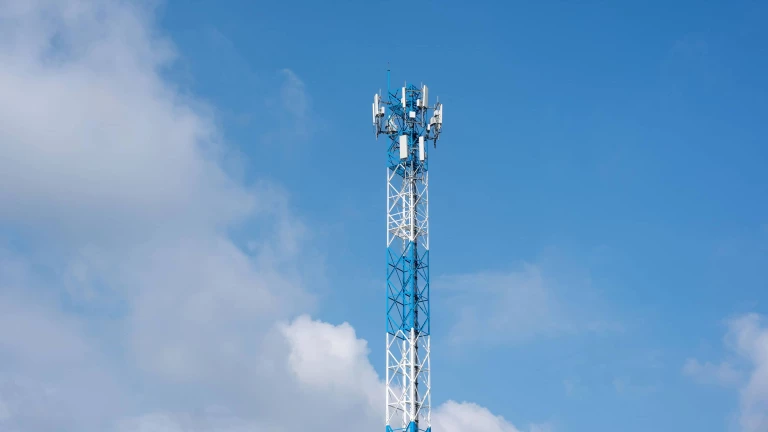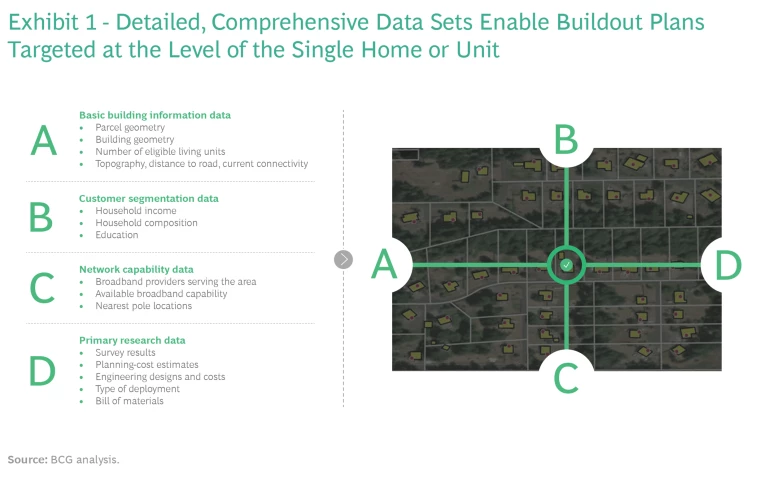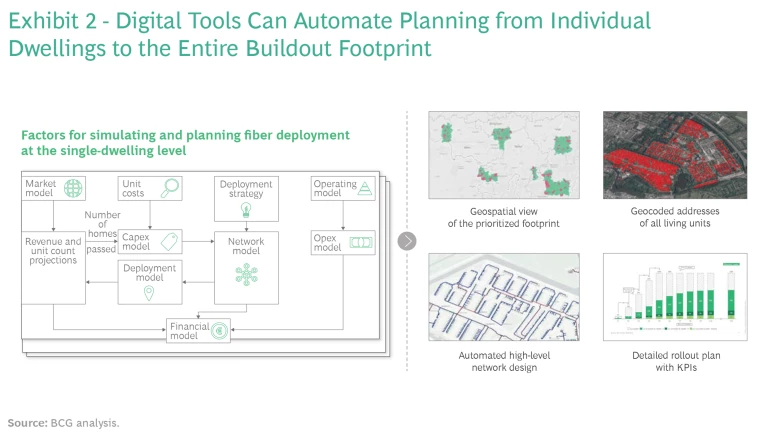Telecom operators have ambitious plans to build out broadband across the country. To maximize the value of the capital deployed, they must implement the right strategies, processes, and tools.
This is turning out to be a pivotal year for broadband in the US. All the major stakeholders in the telecom sector —large and small providers as well as local, state, and federal government agencies—are making commitments to bridge the digital divide. The goal: close the broadband-access gap that continues to perpetuate decades of economic disadvantage faced by the country’s most vulnerable communities. It has been encouraging to observe the renewed determination to ensure connectivity for all—a necessary first step toward enabling economic and educational parity.
The federal government has committed billions to this effort, so it behooves operators to reimagine how to deploy capital on an entirely new scale.
Over the coming months and years, operators will be laying the fiber and installing the next-generation radio systems needed to establish last-mile connectivity to homes and businesses. The federal government has committed billions to this effort, so it behooves operators to reimagine how to deploy capital on an entirely new scale, rethinking the underlying economics to ensure the greatest bang for their buck.
How can companies create the most value through changes in their management of fiber deployment? And what specific technologies and techniques should they implement to complete the task? In this article, we lay out the strategic and tactical levers operators should pull to build their fiber networks faster, better, and cheaper.
Determining the Right Strategy
The key to successful fiber deployment lies in understanding the complex, interconnected factors that lead to efficient buildouts, especially in suburban or rural areas. The more efficient the overall process, the more access for those who most need it—and the more profitable. When determining the right strategy for building out in historically unprofitable areas, companies will need to take the following actions:
- Establish a comprehensive data set and efficient tracking capabilities for each eligible site. This will minimize the need for manual data entry, improve transparency into the planning, engineering, and construction processes, and provide transparency to sales teams. In our experience, having early visibility into the eligible market footprint can contribute to 5% to 10% higher take-up rates and a 20% to 25% reduction in network- and construction-planning costs.
- Cluster areas by opportunity, deployment approach, and build sequence to generate the healthiest cash flow and overall ROI. Develop a comprehensive model that accounts for potential footprints for business and retail customers, competitors’ network plans and activities, and regulatory and legal issues. Consider different options for deployment methods, placement of splitters, and fiber and fiber-connector technologies. Once analyzed, determine the optimal combinations for each footprint cluster. Carefully consider the largest area that can be profitably served to minimize costs of resource mobilization, even if it is not within traditional planning parameters. Clustering can lead to the reconfiguration of up to 70% of build plans when viewed through these additional lenses, which in turn can increase revenue potential by 2% to 3% from the same amount of capex.
- Improve build efficiency and speed. Fiber rollouts can be logistically complex, and crew mobilization takes time. Speeding up buildouts requires tight coordination across engineering, construction, and provisioning teams—and maximizing the scale of each mobilized team’s projects. Reduce repeat visits and redundant activity at each site by using tools that can provide transparency and visibility to all parties involved, allowing teams to integrate their activities and maintain close communication. Bidding on adjacent areas can also increase efficiency.
Agile techniques
among cross-functional teams will better align priorities consistently and continuously and enable the rapid coordination of adjustments as needed. Gaining scale at the local level will also lower the unit costs of middle-mile access. In our experience, these practices can drive 20% to 30% reductions in construction cycle time, increasing the number of premises passed within the same target time frame.
Agile techniques among cross-functional teams will better align priorities consistently and continuously and enable the rapid coordination of adjustments as needed.
- Minimize direct unit costs. Optimize the buildout process by minimizing the cost of deployment per premise passed. This can be achieved with high-performing construction crews that use innovative rollout technologies, such as hydraulic circular drilling and microtrenching. Develop digital tools—site-visit scanners, for example—to help guide and enable efficient rollouts. These tools can demarcate area limits and provide capex and topology-impact estimates, thus ensuring that builds are successful on the first pass and reducing the likelihood of incomplete jobs stemming from preventable root causes, such as lack of access. We have seen that a full cost-review-and-optimization program that accounts for all of these techniques can yield reductions in direct unit costs of up to 30%.
- Minimize indirect costs. Historically, copper-based networks required many more operating centers with larger space requirements than new fiber-based IP networks. Reducing the number of centers offers real savings when shifting to fiber. Incumbents should identify opportunities to consolidate operating center assets, even with adjacent operators, to lower expenses associated with the management and maintenance of equipment and facilities. New entrants should identify existing structures with good power and sufficient space that could be repurposed to mitigate the need to build entirely new centers. Optimizing operating centers can drive 20% to 30% reductions in costs, lowering the capex burden on new deployments.
- Exercise alternative-access options in rural areas to boost customer acquisition prior to a buildout. Reducing the lag between the prebuild decision to target customers and acquiring them once they are connected can improve the take-up rate, and thus the ROI, of the buildout. Steps to reduce the lag could include leasing capacity from an overbuilder, where possible, before building fixed wireless-access services to drive up early acquisitions and establish relationships with customers. Such temporary alternate access options can accelerate customer acquisition by 12 to 18 months, leading to a 5% to 10% growth in revenue and a 2% to 5% boost to EBITDA.
- Speed up service delivery after the buildout. A variety of digital tools can significantly reduce the time it takes to provide service to customers. Using these tools will improve overall operational and cost efficiencies, lock in new customers early, and limit delay-driven customer issues that can significantly erode value, such as change of mind, moves, and frustration with the service received. Virtual site visits can identify locations where customers can be connected easily, making it possible to provide them with quick service requiring limited effort. Digital accelerants can speed service delivery to some customers in as little as five days. This underscores the value of selecting the right kinds of network equipment, especially equipment on customers’ premises that can be remotely monitored and managed. Digital tools can reduce cycle times by half for between 30% and 50% of the customer portfolio, and some areas can be made ready for service in just two days.
The Efficient Rollout
Of course, the devil is in the details. Once the overall buildout strategy is in place, telecom companies must carry out the work itself. This includes the engineering, logistics, and construction activities, which, if done properly, can lead to lower initial capex and to considerable gains in long-term profitability.
We have identified five areas that are ripe for greater optimization, with the potential to improve efficiency considerably:
Permitting and Licenses. The engineering phase is critical to efficient buildouts, and operators should use the time to acquire rights of way, permits, and pole-attachment licenses. The permitting process varies widely depending on location, from as long as four months to as short as ten days. Therefore, it is critical to invest in developing granular and thorough plans for permit acquisition and to link those plans with construction goals. Key steps:
- Understand who owns what throughout the construction area, including municipalities, companies, large and small landlords, and individual homeowners.
- Profile locations to capture data on the permit-application timeline and construction window, spot variations in the permitting process, and recognize any state-level regulations or those from the Federal Communications Commission (FCC).
- Develop a playbook tailoring specific approaches to each segment.
When deploying aerial networks, acquiring pole-attachment licenses can be challenging given that it can take up to 45 days to acquire a license and an additional 60 to 90 days to prepare for the work. Poor data quality often results in especially challenging planning processes and inaccurate results. Partnering with third-party data providers and utility companies can substantially reduce licensing delays and maximize rollout efficiency.
We have identified five areas that are ripe for greater optimization, with the potential to improve efficiency considerably.
Planning-automation tools—combined with complete and accurate data-based geographic profiles—can provide visibility into which locations should be prioritized, depending on each location’s relative ease of deployment and locations where licenses may not be needed.
Supply Management and Logistics. It is likely that, owing to the nature of the suburban and rural locations where they are looking to deploy fiber, many operators will face significant challenges in making sure the right supplies and materials are available. Challenges include the sheer volume of materials needed, coordination of supply points with work sites, having access to adequate space at supply points, and seasonally required supply adjustments.
To overcome these challenges, operators should maintain regional logistics points as close as possible to work sites so that they can provide materials on a day-to-day basis. The buildout plans for each work site should be checked to ensure that only the supplies needed are delivered. The idea is to incorporate the principles of just-in-time inventory (particularly in nonurban areas), rather than maintaining all the supplies required for a full project.
The optimal way to maintain adequate supplies at the lowest cost—where feasible geographically—is to contract with a separate logistics supplier that maintains local warehouses close to construction sites, even if only on a temporary basis. This ensures that the supplies are always accessible and that they can be treated as capital expenses. Much of this work is now typically outsourced, so success will require close interaction with the logistics provider, including the careful tracking of operational KPIs based on quantitative analysis and specific targets.
Early Subscriber Acquisition. Lessons learned from previous broadband rollouts make clear the need to acquire customers early to optimize ROI. Signing up subscribers even before the project is launched, and then maximizing acquisition in the first 12 months after rollout is complete, can add substantial additional revenue after two years.
Beginning at least six months before the start of the rollout, operators can generate support for the plan from local government officials and key opinion leaders by working with them to promote the benefits of broadband and build excitement among early adopters. A concerted public relations effort that includes advertising and commitments from local influencers can build buzz for broadband and create demand among consumers. The marketing team can then begin to promote specific broadband plans to potential subscribers and work toward getting permission to connect them. Only then should the actual rollout begin.
To ensure success, operators should closely monitor key metrics—including consumer awareness of broadband, subscriptions sold, homes connected, and homes activated— before and during the actual construction phase.
Automation. To maximize efficiency, many companies are now trying to fully automate the end-to-end deployment process, integrating advanced digital tools that can capture and analyze all relevant data during the engineering, construction, and provisioning phases. (See Exhibit 1.)
Leading companies are also starting to create comprehensive digital twins of their targeted footprints that contain a complete set of attributes for each site. These include the location and type of each site (whether single-family home or multidwelling unit, for instance), site demographics, associated terminal locations and type, site-drop parameters, photos of the site and installed equipment, and more. (See Exhibit 2.) Having access to this data will allow broadband providers to produce a high-level network design for all targeted areas and combine visual blueprints with geoinformation-system capabilities to refine assumptions, assess economics for different scenarios, and pick and sequence areas for deployment.
With these tools, companies no longer need to choose an area, invest hours in producing a high-level design, and then spend even more time refining the design to meet target financial metrics. Optimal design for an entire US state—or an even larger footprint—can be completed in a matter of hours and then manually refined, if needed.
Team Dynamics. Deploying automation tools and improving transparency into the construction process will enable broadband providers to pivot from rigid, standardized practices to a more flexible organizational model focused on dealing with issues at the local level. Teams organized around agile deployment clusters are more effective in addressing regulatory specifics and accumulating the knowledge needed to remove roadblocks in acquiring rights of way, permits, and attachment licenses. Including sales and marketing as part of the agile fiber-deployment team results in even better outcomes. Modern digital marketing tools can capture data on the potential subscriber base at a very granular level in the right timeframe and support digitally enabled sales campaigns designed to lock in subscribers early.
Boosting Returns
It is encouraging to see a concerted effort across the telecom sector to build and extend broadband access to currently underserved sections of the country. To maximize efficiency, operators must get started immediately, devising and implementing strategies best suited to the locations they hope to serve. And they must plan now to implement the practices and digital tools needed to build out fiber networks in the most efficient way possible. Doing so can unlock tremendous economic and educational benefits while giving operators access to a new, underserved subscriber base in a way that offers the greatest returns.












